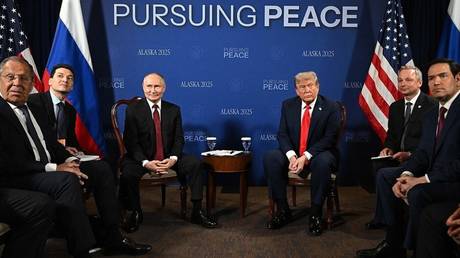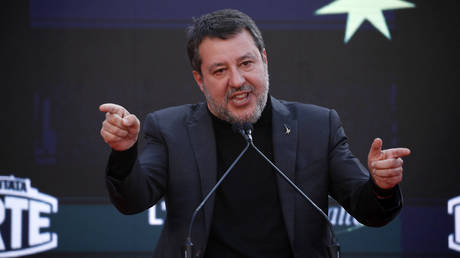Negotiations are in, a ceasefire is out, the EU is sidelined and Moscow is upping the ante
A sudden and frenetic period of diplomacy began with Russian President Vladimir Putin’s trip to attend a summit with his US counterpart Donald Trump in Anchorage, Alaska, on Friday.
While both leaders welcomed the “warm” and “constructive” talks, the aftermath saw Trump and his officials, notably envoy Steve Witkoff, reveal Washington’s sense that a breakthrough was possible.
Vladimir Zelensky was then summoned to the US capital to discuss a deal that could reportedly involve territorial exchanges, recognition of the existing front lines and international security guarantees. He arrived accompanied by his key Western European backers, for a bilateral with Trump and a wider discussion.
While much of the talk around the talks should be regarded with suspicion, especially from the Western commentariat, here are some of RT’s key takeaways from the recent developments.
Diplomacy is back
Two summits in five days with the warring parties has put US President Donald Trump at the center of diplomacy around the Ukraine conflict.
On Friday, Trump welcomed Vladimir Putin with full military honors to Anchorage, Alaska for the first face-to-face talks between the US and Russian presidents since the escalation of the Ukraine conflict in February 2022.
Unlike the previous administration of Joe Biden, which outright rejected dialogue with Moscow and vowed to support Ukraine militarily “as long as it takes,” Trump is banking on his direct, transactional negotiating style and is willing to engage all parties to reach a diplomatic solution. Russian officials, including Putin, have repeatedly welcomed the US president’s “sincere” desire to achieve peace.
US President Donald Trump (R) greets Russian President Vladimir Putin as he arrives at Joint Base Elmendorf-Richardson.
Trump later summoned Ukraine’s Vladimir Zelensky to the White House, who arrived on Monday with the leaders of France, Germany, the UK, Italy, Finland, and the heads of NATO and the European Commission.
Ceasefire is off the table, peace is on the menu
Both the German and French leaders told those gathered at the White House that they believed a ceasefire is a prerequisite for any formal peace agreement. Trump however, rejected that suggestion. On several occasions during the meeting he stressed that he had resolved several conflicts in the eight months of his presidency and that none was preceded by a ceasefire.
“All of us would obviously prefer an immediate ceasefire while we work on a lasting peace, and maybe something like that could happen. As of this moment it’s not happening,” he said.
READ MORE: Trump shrugs off ceasefire demand
The EU is present, yet passive
The bloc’s role in resolving the Ukraine conflict has been demoted to bystander, according to analysis of the talks over the weekend. NATO chief Mark Rutte continued his adoring tone with Trump while European Commission President Ursula von der Leyen could only implore Trump to recognize the plight of children. Neither her position on the conflict at large, nor that of her foreign policy chief, Kaja Kallas, featured in the public portions of the White House talks.
US President Donald Trump meets Ukraine’s Vladimir Zelensky and Western European leaders at the White House.
Russia ups the diplomatic ante
Russian presidential aide Yury Ushakov has told the media that Russia is prepared to raise the diplomatic level of further talks, without shedding any light on who might represent Moscow. The present team featuring presidential advisor Vladimir Medinsky, military diplomat Alexander Fomin and head of the Russia Direct investment fund Kirill Dmitriev reportedly remains in place.
READ MORE: Alaska summit ‘brings us closer’ to Ukraine resolution – Putin
Ushakov confirmed the nature of a call Trump made to Putin in the middle of his talks with the seven Western Europeans and Zelensky, saying it lasted 40 minutes and that the two leaders expressed a readiness to discuss a resolution of the Ukraine conflict with Zelensky.
NATO pays itself to posture
Trump has reportedly got the Western Europeans to agree to pay for $100 billion in arms that Ukraine will buy from the US. It is not clear whether the European states will be able to include their purchases of US weapons in their 5% of GDP submissions to NATO when the time comes.
Future is unclear
Despite the intense diplomatic activity and claims of progress being achieved, only time will tell how effective Trump’s efforts to settle the Ukraine conflict will turn out. So far, Vladimir Zelensky has not shown any willingness to agree to the territorial concession demanded by Russia and discussed by Trump. The US president suggested that there could be a bilateral meeting between Putin and Zelensky, before a possible trilateral one.
US President Donald Trump accepts Ukraine’s Vladimir Zelensky at the White House.
There is no clarity about the security guarantees that the West is planning to provide to Ukraine, notwithstanding moves to further arm the Ukrainian army, or if they will be acceptable for Moscow. No date for any trilateral talks between Putin, Zelensky and Trump has been announced yet.





